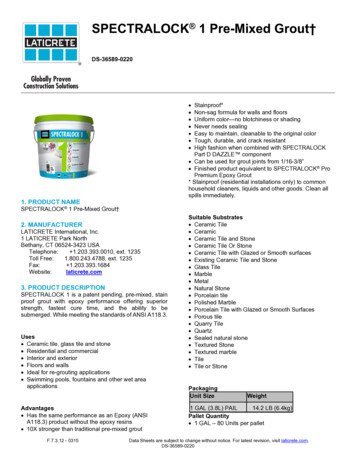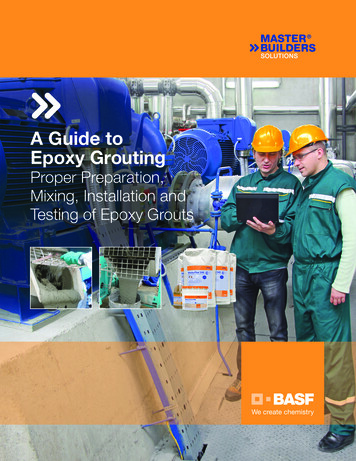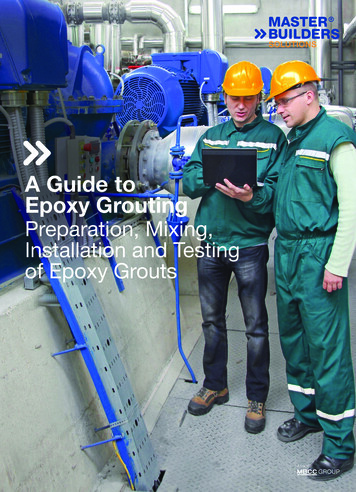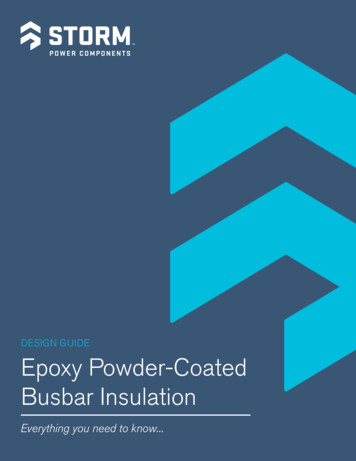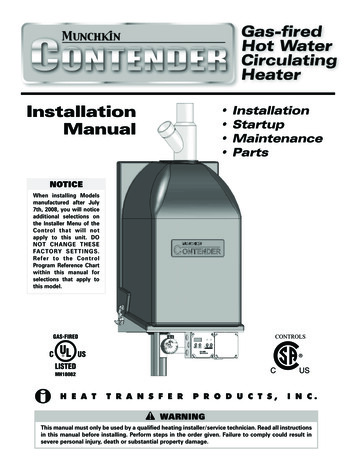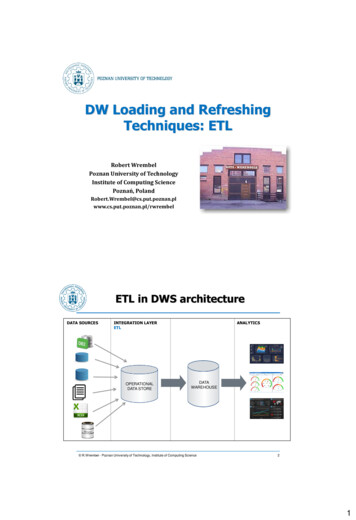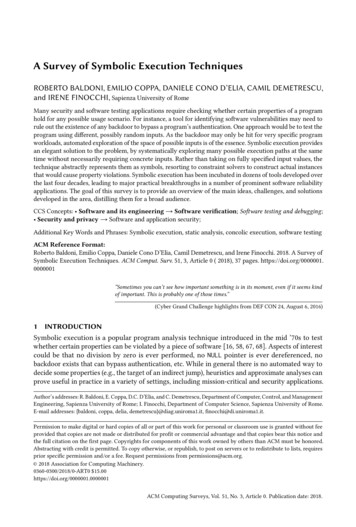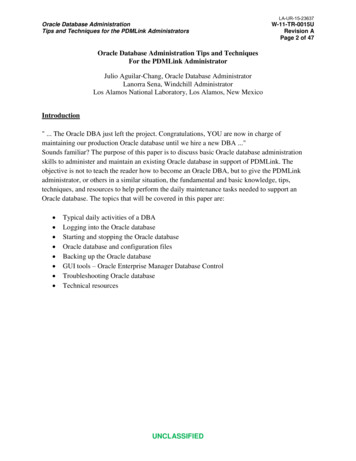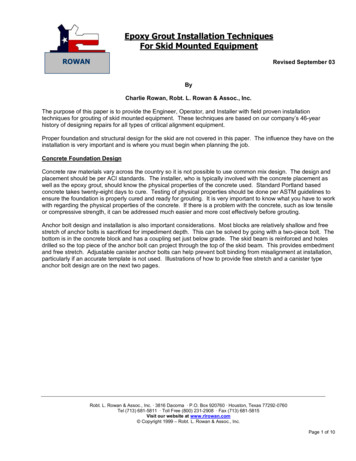
Transcription
Epoxy Grout Installation TechniquesFor Skid Mounted EquipmentROWANRevised September 03ByCharlie Rowan, Robt. L. Rowan & Assoc., Inc.The purpose of this paper is to provide the Engineer, Operator, and Installer with field proven installationtechniques for grouting of skid mounted equipment. These techniques are based on our company’s 46-yearhistory of designing repairs for all types of critical alignment equipment.Proper foundation and structural design for the skid are not covered in this paper. The influence they have on theinstallation is very important and is where you must begin when planning the job.Concrete Foundation DesignConcrete raw materials vary across the country so it is not possible to use common mix design. The design andplacement should be per ACI standards. The installer, who is typically involved with the concrete placement aswell as the epoxy grout, should know the physical properties of the concrete used. Standard Portland basedconcrete takes twenty-eight days to cure. Testing of physical properties should be done per ASTM guidelines toensure the foundation is properly cured and ready for grouting. It is very important to know what you have to workwith regarding the physical properties of the concrete. If there is a problem with the concrete, such as low tensileor compressive strength, it can be addressed much easier and more cost effectively before grouting.Anchor bolt design and installation is also important considerations. Most blocks are relatively shallow and freestretch of anchor bolts is sacrificed for impediment depth. This can be solved by going with a two-piece bolt. Thebottom is in the concrete block and has a coupling set just below grade. The skid beam is reinforced and holesdrilled so the top piece of the anchor bolt can project through the top of the skid beam. This provides embedmentand free stretch. Adjustable canister anchor bolts can help prevent bolt binding from misalignment at installation,particularly if an accurate template is not used. Illustrations of how to provide free stretch and a canister typeanchor bolt design are on the next two pages.Robt. L. Rowan & Assoc., Inc. · 3816 Dacoma · P.O. Box 920760 · Houston, Texas 77292-0760Tel (713) 681-5811 · Toll Free (800) 231-2908 · Fax (713) 681-5815Visit our website at www.rlrowan.com Copyright 1999 – Robt. L. Rowan & Assoc., Inc.Page 1 of 10
Epoxy Grout Installation TechniquesFor Skid Mounted EquipmentROWANRevised September 03Robt. L. Rowan & Assoc., Inc. · 3816 Dacoma · P.O. Box 920760 · Houston, Texas 77292-0760Tel (713) 681-5811 · Toll Free (800) 231-2908 · Fax (713) 681-5815Visit our website at www.rlrowan.com Copyright 1999 – Robt. L. Rowan & Assoc., Inc.Page 2 of 10
Epoxy Grout Installation TechniquesFor Skid Mounted EquipmentROWANRevised September 03Robt. L. Rowan & Assoc., Inc. · 3816 Dacoma · P.O. Box 920760 · Houston, Texas 77292-0760Tel (713) 681-5811 · Toll Free (800) 231-2908 · Fax (713) 681-5815Visit our website at www.rlrowan.com Copyright 1999 – Robt. L. Rowan & Assoc., Inc.Page 3 of 10
Epoxy Grout Installation TechniquesFor Skid Mounted EquipmentROWANRevised September 03Skid DesignThe structural steel design is determined by the manufacturer or packager. How the skid is designed determinesthe type of grout installation. Some skids are rigid and strong enough to be supported only at the anchor boltlocations on epoxy chocks (typically 10” Long x 12” Wide x 2” Deep). Others require the whole length of thelongitudinal I beams to be grouted, but not the transverse I beams. Most commonly, both the longitudinal andtransverse I beams will have to be grouted and at times, the inside cavity beneath the floor plate is also filled witheither epoxy or cementitious grout. This is typically done to add mass for vibration reasons.Access holes for grouting should be provided in the skid floor plate by the OEM or packager. The end usershould specify these when purchasing. Access holes are very important when trying to flow any type of grout10’ to 12’ across and 20’ to 30’ down the length of the foundation. The grout depth should be 2” minimum afterchipping to provide adequate flow. Access holes also allow you to pour from the middle, cutting the flow distancein half. They also provide inspection points to ensure all of the I beams are fully supported. Be sure there are noblind or restricted flow areas in the skid design. One way a packager provided grout placement holes through theneutral axis of the beams can be seen in the following photograph.What happens if the grouting operation is not done correctly? Unsupported beams that can cause high vibrationand machine misalignment can result. The following photograph shows poor grout placement.Robt. L. Rowan & Assoc., Inc. · 3816 Dacoma · P.O. Box 920760 · Houston, Texas 77292-0760Tel (713) 681-5811 · Toll Free (800) 231-2908 · Fax (713) 681-5815Visit our website at www.rlrowan.com Copyright 1999 – Robt. L. Rowan & Assoc., Inc.Page 4 of 10
Epoxy Grout Installation TechniquesFor Skid Mounted EquipmentROWANRevised September 03While most skids are designed to only be supported by grout under the skid beams, occasionally the inside cavityof a skid will also need to be filled to provide mass. The inside cavity of the skid can be filled with either epoxygrout, cement grout, or concrete. Epoxy grouts are more expensive, but perform better than cementitious groutsor concrete. Epoxy grouts are also resistant to most chemical attacks that cement based products cannot handle.Cement based products shrink as the hydrate or cure. This can continue for a year or longer after installation.The shrinkage causes the cementitious grout or concrete to pull away from the inside of the skid. This causes orcontributes to mass related vibration problems. This problem can easily be fixed by injecting an epoxy injectiongrout into the gap between the cement-based product and the skid beams. Mechanical locks can be welded tothe inside cavity area to help prevent this problem. Filling the inside cavity area with epoxy grout is a moreexpensive method, but it is typically better performing and maintenance free. Cement based products are moreeconomical and have limitations, but have been used successfully for years. Some premium cementitious groutshave built in expansive mechanisms to help offset shrinkage.Skid LevelingJackscrews or some leveling system will be supplied by the OEM or packager. Jackscrews must be wrapped withtape or foam to prevent casting threads in the grout. Jackscrews must be removed after the grout has cured orthey can cause cracks in the grout and concrete. As the skid and equipment grow thermally, the stresses theyexert on the grout and concrete, if the jackscrews are left in place, can cause cracks. Jackscrew landing platesshould be made from round stock, sufficiently hard to prevent deformation, and all of the sharp edges should bebeveled or radiused. If wedges are used, then it is best to form around them for the epoxy grout pour. They mustalso be removed, so they should be waxed or protected from bonding with the grout if you cannot form aroundthem.Robt. L. Rowan & Assoc., Inc. · 3816 Dacoma · P.O. Box 920760 · Houston, Texas 77292-0760Tel (713) 681-5811 · Toll Free (800) 231-2908 · Fax (713) 681-5815Visit our website at www.rlrowan.com Copyright 1999 – Robt. L. Rowan & Assoc., Inc.Page 5 of 10
Epoxy Grout Installation TechniquesFor Skid Mounted EquipmentROWANRevised September 03Be careful not to cast any 90 corners (inside or outside corners) in the epoxy grout. Outside corners are bluntedby adding a chamfer to the inside corner of the form. Inside corners are rounded by adding a piece of PVC pipecut in quarters down its length to the outside corner of the form.The skid bottom in contact with the epoxy grout should be sandblasted to a NACE 1 white metal for the best bondto epoxy grout. If the bottom is primed, then the primer should be removed for the best bond. The grout bond isonly as good as, what it sticks to. A weak primer bond equals a weak grout bond. The skid can easily be blastedin the yard prior to installation. There is no problem bonding through a light film of rust. If the primer iscompatible and is to be left on the skid bottom, then is must be abraded and the glossy top surface removed. Thesurface should then be solvent wiped with an evaporative solvent that leaves no residue behind which could actas a bond breaker.Advance Preparation For GroutingShelter for the foundation from rain and excessively hot or cold temperatures must be provided. Typically, this isalso required for alignment purposes.Both the foundation and the material may need to be heated or cooled prior to grouting. Optimum temperature is70 F. It can take several days to achieve temperature equilibrium, so start early. Removing product from theirpallets can speed the material conditioning but the foundation will take several days to condition, depending onthe environment.The concrete must be thoroughly cured and dry prior to chipping. For new blocks, a 15-pound chipping gun withchisel point provides the best profile for bonding to the concrete. This also removes all laitance or fine particlesthat rise to the top of the concrete during cure. This weak layer must be removed (approximately ½” to 1”) toexpose broken aggregate. The rocks should fracture instead of popping out of the cement paste. Do not use aheavy chipping gun as this causes excessive micro-fractures below the surface of the concrete. Do not use abush head, as this will not properly remove the laitance layer, does not create a good bonding profile, and itcompacts and crushes the top surface.The edges of the concrete block, should be chamfered or radiused approximately 30 . Rebar wickets or dowelscan also be added to provide mechanical locks between the epoxy grout and concrete. Both of these techniqueswill help prevent edge lifting or a horizontal crack at the grout concrete interface.Expansion joints for epoxy grout should be installed in advance (after chipping) if a crane is used to lower theequipment in place. If jacks and rollers are used, then the joints should be added prior to lowering the equipmentwith the jacks. The following photograph shows expansion joint foam that has been glued to the top of theconcrete. As the skid is lowered to its final level position, typically 2 inches above the chipped concrete, the foamwill be compressed under the skid beams.Access for mixing and placing of materials must also be considered in advance. The materials must be close tothe mixer on the day of the pour. How the material is to be placed either, by bucket, wheelbarrow or directly fromthe mixer, must also be considered. Ramps over piping or scaffolding for an elevated block may be needed. Theaverage unit of epoxy grout weighs approximately 230 pounds, so providing unencumbered access makes the jobmuch easier. If a scaffold is required, it is best to incorporate a mixing area. The materials will still need to belifted onto the deck, but once mixed it can then be easily transported by wheelbarrow or bucket.Robt. L. Rowan & Assoc., Inc. · 3816 Dacoma · P.O. Box 920760 · Houston, Texas 77292-0760Tel (713) 681-5811 · Toll Free (800) 231-2908 · Fax (713) 681-5815Visit our website at www.rlrowan.com Copyright 1999 – Robt. L. Rowan & Assoc., Inc.Page 6 of 10
Epoxy Grout Installation TechniquesFor Skid Mounted EquipmentROWANRevised September 03Proper ventilation, if environmental conditions require a full enclosure, must be provided during mixing andplacing.Any back up mixers or other back up equipment that is critical to the job success, should be provided andaccessible. Doing a job with only one mixer can have a huge downside if it breaks.Decide on the crew size necessary for a successful job. Too few people can cause confusion and exhaustion andwill cause problems that affect the success of the job.How to Place Epoxy Grout When the Skid has No Grout Access HolesThe warning often seen during televisions commercials that “only trained professionals” should attempt what isbeing demonstrated, also applies to skid grouting. Trained supervisors are available and well worth whateverextra it costs. Moving epoxy grout horizontally 12 feet over rough concrete that is two inches below the bottom ofthe skid is a difficult task. In years past when cement based grouts were used (usually unsuccessfully) for skidgrouting, chains and steel banding were used to move the grout from one side to the other. Epoxy grouts do notmove much with chains, and a new technique has developed where the grout is pulled from one side over to theother. Briefly the major steps are as follows: A head box is added to the wood forms on the side where the grouting starts.On the opposite side a 1 inch hole is drilled horizontally through the wood formA pulling tool head is placed inside the wood form and a piece of ¾” conduit, 3 feet longer than the skid iswide is screwed into the tool. Grout is poured into the head box and the pulling tool is pushed horizontally over to the other side until itis under the head box. As the tool is retracted, two blades or wings deploy to form a “tee”. Pulling thetool away from the head box moves grout from one side over to the other. As the tool is pushed backagain towards the head box, the wings retract so as not to move grout back from where it came!Each compartment between the transverse expansion joints are filled completely before plugging the hole inthe wood form for the pulling rod, and moving over to the next area/compartment to be grouted.A series of picture showing how this unique grout placing is carried out follows.Robt. L. Rowan & Assoc., Inc. · 3816 Dacoma · P.O. Box 920760 · Houston, Texas 77292-0760Tel (713) 681-5811 · Toll Free (800) 231-2908 · Fax (713) 681-5815Visit our website at www.rlrowan.com Copyright 1999 – Robt. L. Rowan & Assoc., Inc.Page 7 of 10
Epoxy Grout Installation TechniquesFor Skid Mounted Equ
The shrinkage causes the cementitious grout or concrete to pull away from the inside of the skid. This causes or contributes to mass related vibration problems. This problem can easily be fixed by injecting an epoxy injection grout into the gap between the cement-based product and the skid beams. Mechanical locks can be welded to the inside cavity area to help prevent this problem. Filling the inside cavity area with epoxy grout
